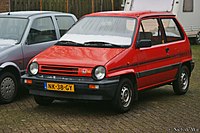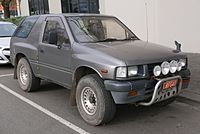Wikimedia Commons has media related to Honda Jazz .
The Honda Jazz nameplate has been used by the Japanese manufacturer Honda to denote several different motorized vehicles since 1982:
- 1982–1986 — The first generation Honda City when marketed in Europe, as Opel owned the City name
- 1986–2001 — A 50 cc cruiser-style motorcycle (AC09)
- 1993–1996 — Japanese-market name for a badge-engineered Isuzu MU (Isuzu Amigo)
- 2001–present — In Europe, Oceania, the Middle East, Southeast Asia, India, and Africa the Honda Fit five-door hatchback automobile is sold as the Jazz
- 2002–2009 — Canadian-market name used on the Honda CHF50 scooter
- Honda Jazz (1982–1986)
- Honda Jazz (AC09, 1986–2001), similar to the Magna pictured
- Honda Jazz (UCS69) (1993–1996)
- Honda Jazz (June 2001–present)
- Honda Jazz scooter (1996–2002)




